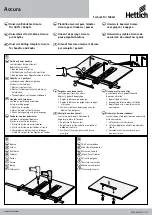
Model No. ME-9858
Physical Pendulum Accessory
11
®
Using equation #8, calculate the resulting KE of the pendulum.
How do these two values compare? Calculate the percent difference between them. How
"elastic" was the rubber band collision? What are the sources of error? Did you lose or
gain energy? What would you expect? Explain why.
Appendix A: DataStudio Setup Instructions
Procedure
Steps
PART I:
Plug the
photogate into the
interface:
PASPORT:
a)
Plug the Photogate Port into either port on a PASPORT
Photogate Port.
b)
Plug the Photogate Port into a PASPORT interface.
c)
Connect the PASPORT interface (i.e. USB Link, PowerLink, etc.) to a
USB port on your USB-compatible computer.
d)
When the PASPORTAL
window opens, select “Launch DataStudio.”
OR
ScienceWorkshop: a)
Plug the stereo plug on the Photogate into a
ScienceWorkshop
interface.
b)
Launch DataStudio.
PART II:
Set up your
experiment
PASPORT: a)
In the PASPORT Setup window, click on the
Add Timer
button and select Photogate Timing from the available choices.
b)
At
the prompt, enter the flag length and photogate spacing and click
OK
.
c)
In the PASPORT Setup window, scroll to the Photogate Timing box, and
select “time in gate” and “velocity in gate.”
OR
ScienceWorkshop:
a)
In the Welcome to DataStudio window, double
click “Create Experiment.”
b)
In the Sensors list, click and drag a
Photogate icon to the picture of the interface (i.e. to the same digital
channel in which you have the photogate connected.)
c)
In the
Experiment Setup window, double click on the Photogate icon.
d)
In the
Measurement tab, select “time in gate” and “velocity in gate.”
e)
In the
Constant tab, enter the flag length in meters and click
OK
.
f)
In the main
toolbar, click the
Timers
button.
g)
Under Label, type a name for your
timing sequence.
h)
Click on the down arrow next to channel 1 and
select “blocked.”
i)
Click on the arrow again and select “unblocked.”
j)
Click the
Done
button to save your timing scheme.
PART III:
Create the
velocity equation
a)
Click the
New
button to create a new equation. In the equation box,
type in the velocity equation: v=d/t, where v= velocity in m/s, d=distance
in meters, and t=time in seconds. Click the
Accept
button.
b)
Under
Variables, next to variable “d”, click on the down arrow, select constant,
and type in the flag distance from leading edge to leading edge (about
.001 m).
c)
For variable “t”, click on the down arrow, select “data
measurement,” “time in gate” and click OK. (For more instructions on
building equations, see the DataStudio online help.)]
PART IV:
Collect Data
a)
From the Data list, drag the velocity equation over a y-axis in a
separate Table display.
b)
Click the
Start
button on the main toolbar.
KE
1
2
---
I
ω
2
=
Содержание Physical Pendulum Accessory
Страница 1: ...Instruction Manual Manual No 012 08581A Physical Pendulum Accessory Model No ME 9858...
Страница 2: ......































